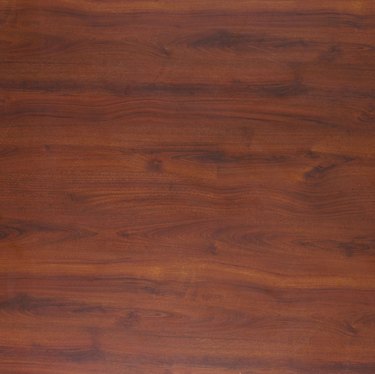Things You'll Need
150-grit sandpaper
Tack cloth
Oil-based polyurethane
Mineral spirits, unscented
Glass jar
Foam or natural-bristle brush
#0000 steel wool
Straight-edge razor scraper
Lemon oil or mineral oil
Clean, soft cloths or paper towels

Polyurethane is one of the hardest protective finishes for wood furniture that the average do-it-yourselfer can successfully apply. It forms a protective finish that is as hard as glass. Polyurethane brings out the natural beauty of the wood grain. It is harder, more durable and dries more quickly than varnish. Polyurethane is available in a glossy, satin or matte finish.
Step 1
Sand any rough spots on your bare-wood piece of furniture. Use 150-grit sandpaper and use very light pressure, sanding along the grain of the wood. Wipe the piece with a tack cloth to remove sanding dust.
Video of the Day
Step 2
Stir the contents of the can of polyurethane gently, to reduce the formation of air bubbles. Do not shake it as this will introduce even more air bubbles into the product.
Step 3
Mix one part of mineral spirits and two parts of polyurethane in a glass jar. This is the base, or sealer coat. Do not stir too vigorously, to minimize air bubbles.
Step 4
Apply the sealer coat to the bare wood, using a foam brush or natural-bristle brush. Brush on the polyurethane using long strokes, slightly overlapping each pass. For table and dresser tops, do the sides first, then start in the middle of the top and work your way out to the edges. Always brush from wet polyurethane into a non-coated area, to minimize defects in the finish.
Step 5
Allow the first coat of polyurethane to dry for at least 24 hours before proceeding.
Step 6
Buff the piece of furniture with #0000 steel wool pads. Use a light touch so as not to mar the finish. Wipe off the sanding dust with a tack cloth.
Step 7
Apply a second coat of polyurethane, using the same ratio of mineral spirits to polyurethane, as well as the same technique used to apply the first coat. Let the second coat dry for at least 24 hours.
Step 8
Wipe all over the piece with #0000 steel wool, using a light touch to remove any surface imperfections. Wipe off the sanding dust with a tack cloth.
Step 9
Brush on a third coat of polyurethane, this time use it full-strength, without adding mineral spirits. Use long strokes, from one end of the piece to the other, overlapping each pass slightly until the entire piece is coated.
Step 10
Let the third coat dry for at least 48 hours.
Step 11
Shave off any runs or globs of hardened polyurethane using a straight-edge razor scraper. Don't cut too deeply, or you will mar the finish.
Step 12
Saturate a piece of #0000 steel wool with lemon oil or mineral oil. Apply the oil to the piece by wiping over it with the oil-saturated steel wool, using light pressure. Let the oil dry and soak in for 30 minutes and then wipe off the excess with a clean, soft cloth or paper towels. This step will remove any rough patches and give the piece a smooth finish.
Step 13
Apply two sealer coats of polyurethane mixed with mineral spirits to the underside of the piece of furniture if it is made of traditional hardwood lumber. Wood pieces that are not completely sealed with polyurethane can warp because moisture can enter the wood through the unsealed surface. This step is not necessary if the furniture is made of plywood or particleboard.
Tip
Be gentle when using your piece of furniture for the 30 days following the application of polyurethane. The product will continue to harden during that period and the surface could be marred by rough treatment.
Video of the Day